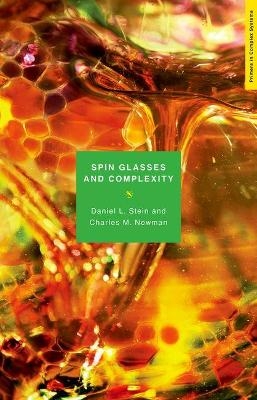
Spin Glasses and Complexity
Princeton University Press (Verlag)
978-0-691-14733-8 (ISBN)
Spin glasses are disordered magnetic systems that have led to the development of mathematical tools with an array of real-world applications, from airline scheduling to neural networks. Spin Glasses and Complexity offers the most concise, engaging, and accessible introduction to the subject, fully explaining what spin glasses are, why they are important, and how they are opening up new ways of thinking about complexity. This one-of-a-kind guide to spin glasses begins by explaining the fundamentals of order and symmetry in condensed matter physics and how spin glasses fit into--and modify--this framework. It then explores how spin-glass concepts and ideas have found applications in areas as diverse as computational complexity, biological and artificial neural networks, protein folding, immune response maturation, combinatorial optimization, and social network modeling. Providing an essential overview of the history, science, and growing significance of this exciting field, Spin Glasses and Complexity also features a forward-looking discussion of what spin glasses may teach us in the future about complex systems.
This is a must-have book for students and practitioners in the natural and social sciences, with new material even for the experts.
Daniel L. Stein is professor of physics and mathematics at New York University's Courant Institute of Mathematical Sciences. His books include Spin Glasses and Biology. Charles M. Newman is professor of mathematics at NYU's Courant Institute of Mathematical Sciences and at the University of California, Irvine. His books include Topics in Disordered Systems.
Preface xi Introduction: Why Spin Glasses? 1 *1. Order, Symmetry, and the Organization of Matter 15 *1.1 The Symmetry of Physical Laws 17 *1.2 The Hamiltonian 23 *1.3 Broken Symmetry 26 *1.4 The Order Parameter 31 *1.5 Phases of Matter 35 *1.6 Phase Transitions 39 *1.7 Summary: The Unity of Condensed Matter Physics 41 2. Glasses and Quenchied Disorder 43 *2.1 Equilibrium and Non Equilibrium 43 * 2.2 The Glass Transition 45 *2.3 Localization 49 3. Magnetic Systems 51 *3.1 Spin 51 *3.2 Magnetism in Solids 53 *3.3 The Paramagnetic Phase 55 *3.4 Magnetization 55 *3.5 The Ferromagnetic Phase and Magnetic Susceptibility 57 *3.6 The Antiferromagnetic Phase 59 *3.7 Broken Symmetry and the Heisenberg Hamiltonian 59 4. Spin Glasses: General Features 63 *4.1 Dilute Magnetic Alloys and the Kondo Effect 64 *4.2 A New State of Matter? 65 *4.3 Nonequilibrium and Dynamical Behavior 71 *4.4 Mechanisms Underlying Spin Glass Behavior 74 *4.5 The Edwards-Anderson Hamiltonian 78 *4.6 Frustration 81 *4.7 Dimensionality and Phase Transitions 83 *4.8 Broken Symmetry and the Edwards-Anderson Order Parameter 85 *4.9 Energy Landscapes and Metastability 86 5. The Infinite-Range Spin Glass 90 *5.1 Mean Field Theory 90 *5.2 The Sherrington-Kirkpatrick Hamiltonian 92 *5.3 A Problem Arises 93 *5.4 The Remedy 95 *5.5 Thermodynamic States 97 *5.6 The Meaning of Replica Symmetry Breaking 98 *5.7 The Big Picture 109 6. Applications to Other Fields 112 *6.1 Computational Time Complexity and Combinatorial Optimization 113 *6.2 Neural Networks and Neural Computation 129 *6.3 Protein Folding and Conformational Dynamics 144 *6.4 Short Takes 168 7. Short-Range Spin Glasses: Some Basic Questions 175 *7.1 Ground States 177 *7.2 Pure States 188 *7.3 Scenarios for the Spin Glass Phase of the EA Model 193 *7.4 The Replica Symmetry Breaking and Droplet/Scaling Scenarios 194 *7.5 The Parisi Overlap Distribution 197 *7.6 Self-Averaging and Non-Self-Averaging 199 *7.7 Ruling Out the Standard RSB Scenario 201 *7.8 Chaotic Size Dependence and Metastates 203 *7.9 A New RSB Scenario 206 *7.10 Two More (Relatively) New Scenarios 211 *7.11 Why Should the SK Model Behave Differently from the EA Model? 214 *7.12 Summary: Where Do We Stand? 216 8. Are Spin Glasses Complex Systems? 218 *8.1 Three Foundational Papers 219 *8.2 Spin Glasses as a Bridge to Somewhere 227 *8.3 Modern Viewpoints on Complexity 228 *8.4 Spin Glasses: Old, New, and Quasi-Complexity 233 Notes 239 Glossary 265 Bibliography 285 Index 309
| Erscheint lt. Verlag | 15.1.2013 |
|---|---|
| Reihe/Serie | Primers in Complex Systems |
| Zusatzinfo | 5 halftones. 48 line illus. |
| Verlagsort | New Jersey |
| Sprache | englisch |
| Maße | 140 x 216 mm |
| Gewicht | 312 g |
| Themenwelt | Mathematik / Informatik ► Mathematik ► Analysis |
| Naturwissenschaften ► Physik / Astronomie ► Elektrodynamik | |
| ISBN-10 | 0-691-14733-7 / 0691147337 |
| ISBN-13 | 978-0-691-14733-8 / 9780691147338 |
| Zustand | Neuware |
| Haben Sie eine Frage zum Produkt? |
aus dem Bereich


